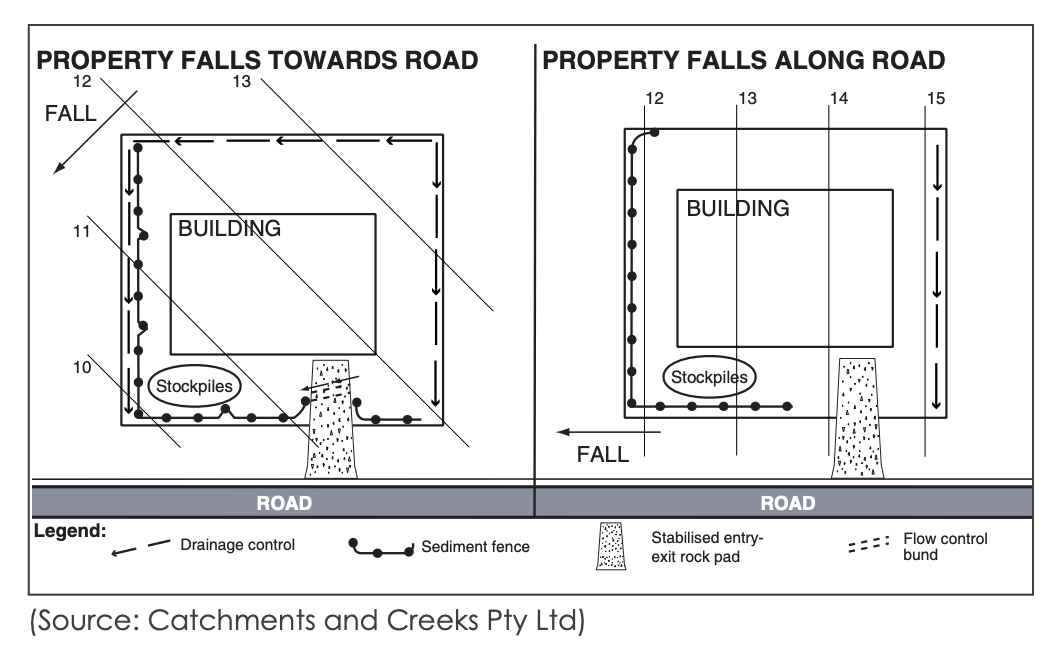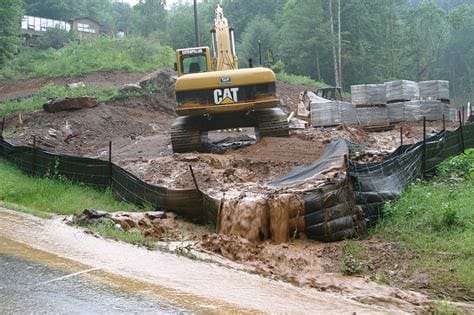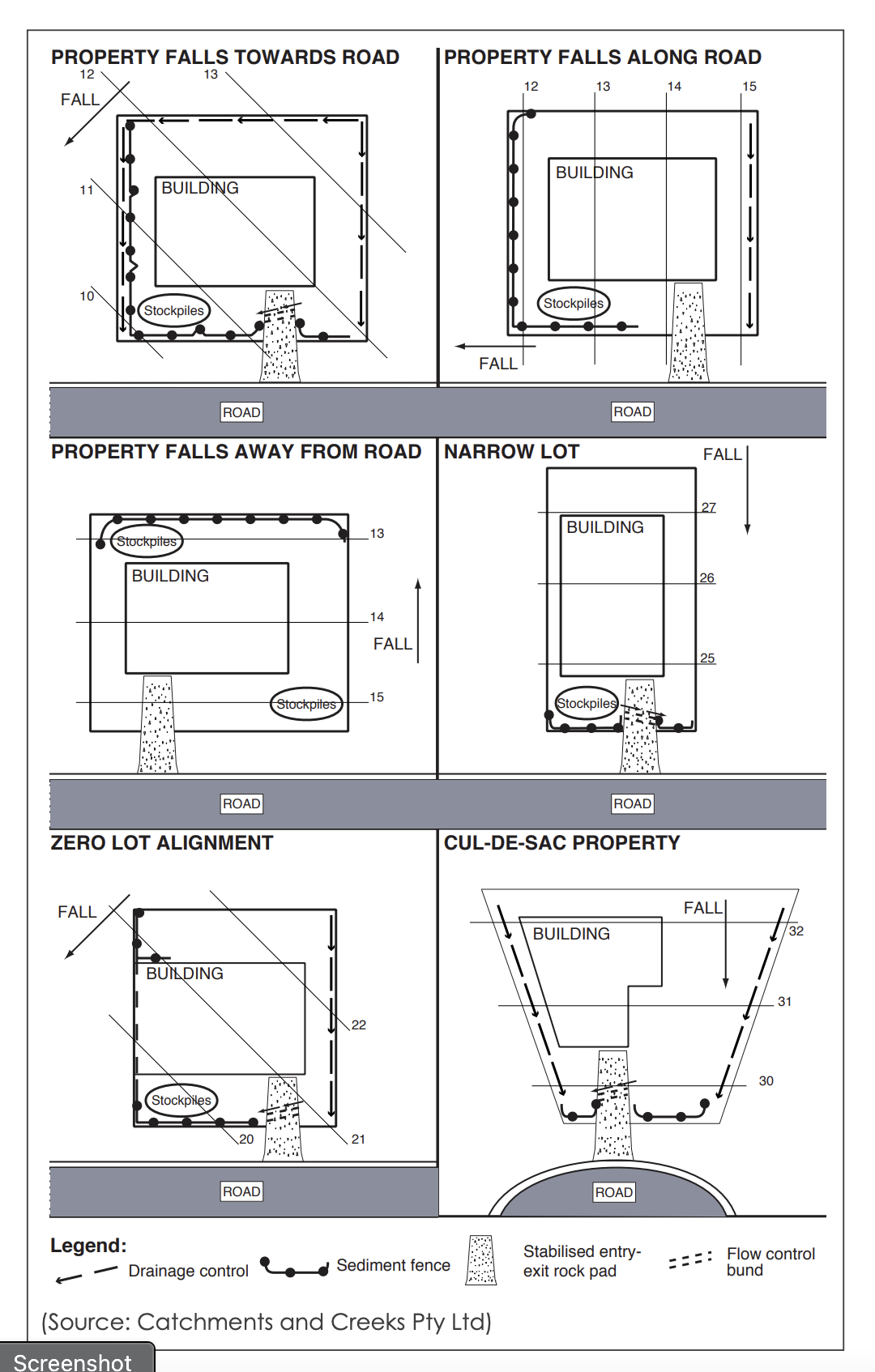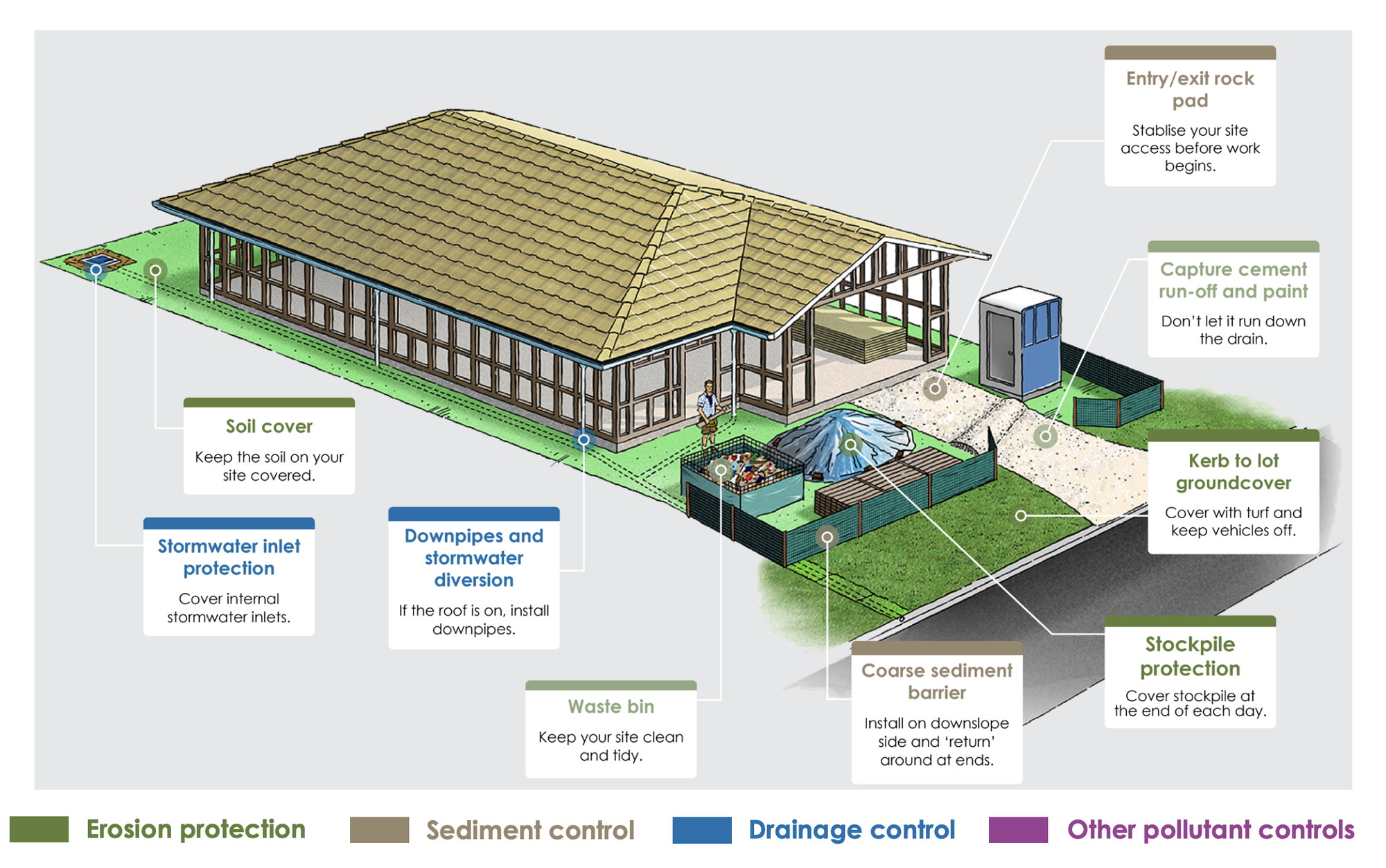Take The Quiz On ESC - Test Your Knowledge
Test your knowledge of ESC planning and measures here.

Introduction
When building your new home, it’s easy to focus on design, materials, and timelines. However, effective project and construction management requires a much broader perspective. Key elements like quality management, risk management, and construction management planning are essential to the success of any project. Within this framework, sediment and erosion control (ESC) plays a vital role.
ESC is not just a box-ticking exercise—it’s an obligation that builders must discharge during the course of construction. By planning and implementing effective ESC measures, builders can prevent soil erosion, sediment runoff, and environmental damage, while also maintaining compliance with Australian regulations.
Importantly, ESC planning also ties directly into the long-term performance of your property. Measures that stabilise soil and manage water runoff contribute to the integrity of your foundation and subsidence policy management. Poor ESC execution can compromise the stability of your site, leading to costly repairs and reduced structural longevity.
By using a comprehensive tool like our C3 checklist, you can effectively plan, monitor, and adjust ESC measures to manage risks, maintain quality, and protect your investment for the long term.
This blog will guide you through everything you need to know about sediment and erosion control, why it matters, and how to use the checklist to make informed decisions.
By the end, you’ll understand how to safeguard your site, minimise risks, and keep your project on track.

What is Sediment and Erosion Control?
Sediment and erosion control (ESC) refers to the practices used to manage soil erosion and prevent sediment from leaving a construction site. When the natural state of land is disturbed during construction, it becomes vulnerable to the effects of wind and water. Without proper management, soil can be displaced, leading to issues like muddy water runoff, clogged stormwater systems, and environmental damage to nearby waterways.
Imagine heavy rains sweeping through your construction site. Without ESC measures, loose soil and debris could easily flow into public drains or neighbouring properties. This not only causes environmental harm but can also lead to legal penalties and project delays.
ESC isn’t just about compliance—it’s about maintaining a safe, sustainable, and efficient construction process. With effective ESC strategies in place, you can ensure that your project minimises its environmental impact while protecting your timeline and budget.
In the next section, we’ll dive into why ESC matters specifically to homeowners and what benefits it brings to your residential construction project.


Why You Should Care About ESC Measures
As a homeowner, you might wonder why sediment and erosion control (ESC) should concern you—it’s the builder’s responsibility, right? While builders do play a key role, understanding ESC measures is equally important for homeowners. Here’s why:
Environmental Impact
In Australia, construction sites are a significant source of sediment pollution, which can harm local waterways and ecosystems. Proper ESC measures help protect the environment by minimising soil erosion and sediment runoff. By ensuring your site complies with ESC practices, you contribute to preserving Australia’s natural beauty and biodiversity.
Regulatory Compliance and Avoiding Penalties
Australian councils have strict guidelines for ESC, and non-compliance can result in hefty fines or stop-work orders. For example, sediment entering stormwater drains is a common violation. Being aware of these regulations ensures you can hold your builder accountable and avoid unexpected costs due to expensive fines or delays.
Cost Savings
Poor ESC management often leads to costly rework, site cleanups, and even structural damage. For instance, un-managed water runoff can destabilise your foundation or erode pathways, leading to future repairs. Proactive ESC planning helps mitigate these risks, saving money in the long run.
Long-Term Site Stability
Investing in proper ESC measures during construction enhances the long-term stability of your property. Well-managed drainage systems and erosion protection measures ensure your land remains secure, even in extreme weather conditions. This not only protects your home but also maintains its resale value.
Understanding the benefits of ESC empowers you to ask the right questions and ensure your project stays on track. In the next section, we’ll take a closer look at the ESC checklist and how it helps you manage these factors effectively.
C3 - The ESC Checklist – An Overview
The sediment and erosion control (ESC) checklist is your essential guide to maintaining site integrity during residential construction. Designed to standardise assessments, this tool helps homeowners and builders identify potential risks, ensure compliance, and manage costs effectively.
Purpose of the Checklist
The ESC checklist aims to:
- Highlight Risks: Identify areas vulnerable to erosion, sediment runoff, and other environmental impacts.
- Standardise Assessment: Provide a structured method for comparing different sites.
- Plan Proactively: Allow homeowners to anticipate potential costs and mitigation strategies.
- Ensure Compliance: Meet local council requirements to avoid fines or delays.
Key Areas of Focus
The checklist is divided into several critical sections, each addressing specific aspects of ESC:
- Planning Your Site: Ensures pre-construction considerations like professional site assessments and compliance documentation are in place.
- Erosion Protection: Focuses on strategies to prevent soil displacement due to wind and water.
- Stockpile & Soil Protection: Addresses the management of exposed soil and stockpiles to reduce erosion risks.
- Drainage Control: Ensures effective water flow management, preventing pooling or runoff into undesired areas.
- Sediment Control: Covers measures to trap sediment and maintain clean access routes.
- Other Pollutant Controls: Handles materials like concrete slurry and wastewater to avoid contamination.
- General Housekeeping: Encourages a clean and organised site, reducing hazards and maintaining efficiency.
Why This Checklist Matters
The ESC checklist not only protects your project but also simplifies decision-making. By walking through each section, you can assess your site’s current conditions and identify areas needing attention. It’s a proactive tool to save time, money, and stress.
In the next section, we’ll explore each of these key areas in more detail, giving you practical insights into their importance and application.

Key Sections of the Checklist Explained
The ESC checklist is divided into actionable sections to guide you through each critical aspect of sediment and erosion control. Here’s a detailed breakdown of these areas:
1. Planning Your Site
Proper planning lays the foundation for successful ESC management. This section ensures all preliminary steps are covered before construction begins.
- Key Actions:
- Engage a qualified professional, or develop your ESC plan (using this checklist) tailored to your site.
- Display the ESC plan prominently for easy access by workers and inspectors.
- Ensure staff and trades are aware of pollution prevention measures and penalties for non-compliance.
- Why It Matters:
Planning ensures compliance with Australian regulations and helps prevent costly oversights. It sets the stage for efficient construction and reduces the likelihood of surprises down the track.
2. Erosion Protection
This section focuses on preventing soil displacement caused by wind or water.
- Key Actions:
- Maintain adequate ground cover, such as turf or straw wattles, on road verges.
- Protect exposed areas of soil, particularly during periods of heavy rainfall.
- Divert upslope clean water around the construction site to minimise erosion risks.
- Why It Matters:
Without erosion protection, loose soil can disrupt your project, damage neighbouring properties, and pollute local waterways, resulting in fines and delays.
3. Stockpile & Soil Protection
Managing stockpiles and soil is essential to control sediment runoff.
- Key Actions:
- Cover all stockpiles with tarps or other protective materials.
- Install drainage controls to prevent water pooling near stockpiles.
- Check exposed soil areas regularly and apply dust control measures when needed.
- Why It Matters:
Stockpiles left uncovered are prone to erosion, which can lead to sediment-laden water entering stormwater systems. This not only violates regulations but also creates additional cleanup costs.
4. Drainage Control
Effective drainage management ensures that water flows where it should, minimising erosion and sedimentation.
- Key Actions:
- Install and maintain drainage diversions to redirect runoff from neighbouring sites.
- Ensure temporary or permanent downpipes are securely connected to stormwater systems.
- Regularly inspect drainage lines for blockages or sediment buildup.
- Why It Matters:
Poor drainage can lead to pooling, foundation damage, and erosion, all of which can delay your project and increase costs.
5. Sediment Control
Sediment control measures prevent soil particles from leaving the site and entering public infrastructure.
- Key Actions:
- Use sediment fences, rumble pads, and sediment traps to catch runoff.
- Keep entry and exit pads clear of excessive sediment to avoid tracking soil onto roads.
- Regularly inspect and maintain all sediment control measures.
- Why It Matters:
Sediment runoff is a leading cause of non-compliance in construction. Proper controls protect both the environment and your project’s timeline.
6. Other Pollutant Controls
This section covers the management of pollutants like concrete slurry, wastewater, and hazardous materials.
- Key Actions:
- Prevent concrete waste and slurry from entering stormwater systems.
- Dispose of contaminated soil and materials responsibly.
- Ensure waste handling is planned and executed effectively.
- Why It Matters:
Pollutants from construction can cause serious environmental damage, leading to fines and reputational harm. Proactive management is crucial.
7. General Housekeeping
A clean, organised site reduces risks and improves efficiency.
- Key Actions:
- Install safety signs and ensure waste skips or cages are conveniently located.
- Clear litter and unconfined rubbish regularly.
- Ensure all materials are secured to prevent them from being blown or washed off-site.
- Why It Matters:
Good housekeeping improves site safety, prevents delays, and ensures compliance with council regulations.

Practical Tips for Using the Checklist
Now that you understand the key components of the sediment and erosion control (ESC) checklist, let’s look at how you can apply it effectively during your residential construction project. These practical tips will ensure you get the most out of this tool.
1. Start Early and Stay Organised
Begin using the checklist during the pre-construction phase.
- Review each section before work starts to identify potential issues.
- Keep a dedicated folder (physical or digital) to store the checklist, site photos, and notes.
Why This Helps: Early identification of risks saves time and money, allowing you to address them proactively instead of reactively.
2. Conduct Regular Inspections
Don’t just check the site once and move on. Use the checklist at key stages:
- Before construction begins.
- At major milestones, such as after earthworks or before pouring concrete.
- After heavy rain or extreme weather events.
Why This Helps: Periodic inspections ensure that ESC measures remain effective and adapt to changing site conditions.
3. Take Tools To Site to Manage and Remediate ESC Items
Having the right tools makes inspections more efficient. Here’s a recommended kit:
- Sledgehammer and claw hammer for quick repairs.
- Shovel and stiff-bristled broom to clear sediment.
- Fluoro line marking spray to highlight areas needing attention.
- Camera or smartphone to document issues and progress.
Why This Helps: Proper tools allow you to address minor issues on the spot and document findings for follow-up.
4. Work Collaboratively with Your Builder
Engage your builder or site manager in the ESC process.
- Ask them to explain their ESC plan and measures.
- Share the checklist to ensure they’re on the same page.
- Use documented issues or photos to hold them accountable.
Why This Helps: Collaboration ensures both you and your builder are committed to maintaining compliance and site quality.
5. Adapt to Site Conditions
No two sites are the same, and conditions can change rapidly.
- Adjust erosion controls based on weather forecasts.
- Add additional sediment controls if runoff increases during heavy rains.
- Ensure drainage lines are clear after storms.
Why This Helps: Flexibility allows you to respond effectively to unforeseen challenges, keeping your project on track.
6. Document Everything
Keep detailed records of your inspections and actions taken.
- Note dates and findings for each section of the checklist.
- Use photos to support observations, especially when escalating concerns to your builder or council.
Why This Helps: Proper documentation protects you in case of disputes or regulatory inquiries.
7. Know When to Call a Professional
While the checklist is a powerful tool, some issues may require expert input.
- Engage an erosion and sediment control specialist for complex problems.
- Consult with your builder or engineer for advice on structural drainage or stormwater management.
Why This Helps: Professionals bring experience and technical expertise, ensuring that critical issues are addressed thoroughly.
Common Challenges in ESC Management
Even with a well-structured checklist, sediment and erosion control (ESC) management can present challenges. Here are some common issues you might face and practical strategies to overcome them.
1. Inadequate Site Planning
Challenge: Skipping the planning phase or failing to assess the unique risks of your site can lead to unanticipated issues.
Solution: Use the ESC checklist during the pre-construction phase to identify potential hazards. Engage professionals to create a tailored ESC plan if needed.
2. Weather-Related Disruptions
Challenge: Sudden rainstorms or strong winds can overwhelm erosion and sediment controls, washing away soil or displacing protective barriers.
Solution: Monitor weather forecasts and reinforce controls before extreme weather events. Use additional measures like straw wattles or temporary covers for extra protection.
3. Poor Maintenance of ESC Measures
Challenge: Over time, sediment fences, rumble pads, and drainage systems can degrade or become clogged.
Solution: Schedule regular inspections and maintenance. Replace damaged materials promptly, and clear sediment from stormwater systems after heavy rainfall.
4. Non-Compliant Practices by Trades or Suppliers
Challenge: Unauthorised activities, such as parking on ground cover or dumping materials improperly, can compromise ESC measures.
Solution: Clearly communicate ESC requirements to all site workers. Use signage to remind trades and suppliers of their responsibilities. Document and address any non-compliance immediately.
5. Mismanagement of Stockpiles
Challenge: Uncovered or poorly placed stockpiles can contribute to soil erosion and sediment runoff.
Solution: Ensure all stockpiles are covered and located away from drainage paths. Install barriers to prevent sediment from washing into stormwater systems.
6. Lack of Accountability
Challenge: Builders or contractors may not prioritise ESC compliance, leaving you to deal with the consequences.
Solution: Use the checklist to hold your builder accountable. Document findings and escalate concerns if necessary, involving council inspectors for persistent issues.
7. Insufficient Knowledge or Expertise
Challenge: Homeowners may lack the technical knowledge to identify or address complex ESC issues.
Solution: Educate yourself using resources like this checklist and engage professionals when needed. Consulting with experts ensures that critical problems are managed effectively.
Check out the Creek & Catchment website (linked below in the resources section).
It has everything you need to fully understand erosion and sediment control (ESC) and how to effectively manage it across a variety of construction sites.
8. Escalating Costs Due to Delays or Rework
Challenge: Ignoring ESC issues can lead to delays and expensive rework, such as fixing erosion-damaged areas or addressing council fines.
Solution: Proactive planning and regular inspections minimise the risk of costly surprises, keeping your project on budget and schedule.
How to Work with Your Builder on ESC
Collaborating with your builder is essential to ensure that sediment and erosion control (ESC) measures are implemented effectively. Here are some practical tips to establish a strong working relationship and maintain ESC compliance throughout your project.
1. Ask the Right Questions
Start by discussing ESC with your builder during the planning phase. Key questions to ask include:
- Do you have a site-specific ESC plan?
- How will you manage sediment and erosion during construction?
- What measures will be in place to address heavy rain or storms?
Why This Helps: These questions set clear expectations and show your builder that ESC is a priority for you.
2. Request Documentation
Ask your builder to share their ESC plan and keep it readily accessible on-site. The plan should include:
- A map of control measures.
- Details about maintenance schedules.
- Contact information for the person responsible for ESC compliance.
Why This Helps: Having access to this information allows you to track progress and identify gaps during inspections.
3. Set Clear Accountability
Identify who is responsible for implementing and maintaining ESC measures. Builders often delegate tasks to subcontractors, so ensure there’s a clear chain of accountability.
Why This Helps: It minimises the risk of tasks falling through the cracks and ensures timely action when issues arise.
4. Use the Checklist as a Collaborative Tool
Share the ESC checklist with your builder and encourage them to use it during inspections. The checklist can help:
- Standardise assessments across all stages of the project.
- Highlight areas requiring immediate attention.
- Document issues and track resolutions.
Why This Helps: Collaboration fosters transparency and ensures both parties are aligned in managing ESC effectively.
5. Conduct Joint Inspections
Schedule regular site inspections with your builder, especially after heavy rainfall or major construction milestones. Walk through the site together and compare findings to the checklist.
Why This Helps: Joint inspections create opportunities to address concerns in real time and prevent small issues from escalating.
6. Escalate When Necessary
If you notice repeated issues or non-compliance, escalate the matter:
- Document your concerns with photos and notes.
- Contact the council or relevant regulatory body if necessary.
Why This Helps: Escalating ensures that persistent problems are addressed, protecting your investment and maintaining compliance.
7. Encourage Proactive Solutions
Builders often have valuable experience with ESC challenges. Ask for their input on:
- Innovative solutions to site-specific issues.
- Cost-effective materials or methods for better results.
Why This Helps: Leveraging their expertise can improve outcomes while maintaining your budget.
8. Focus on Mutual Benefits
Frame ESC as a shared responsibility that benefits both parties. Effective measures not only protect the environment but also streamline construction, reduce risks, and save money for everyone involved.
Why This Helps: A collaborative mindset builds trust and fosters a positive working relationship.
Conclusion
Sediment and erosion control (ESC) is a fundamental component of effective project and construction management. It plays a critical role in mitigating risks that can affect your site, such as regulatory compliance issues, costly delays, and environmental damage. ESC is not just about meeting legal obligations—it’s about ensuring the smooth execution of your construction project from start to finish.
All well-prepared construction management plans should include detailed environmental protection measures. These can be effectively implemented and monitored by following the “Plan, Do, Study, Adjust” methodology. Using a comprehensive tool like our C3 checklist allows you to proactively manage these responsibilities, ensuring that potential issues are identified, addressed, and resolved before they escalate.
By incorporating ESC practices into your construction management approach, you not only protect your property and the environment but also keep your project on track for success. Whether you’re building your first home or overseeing a major construction project, the time and effort invested in ESC will ultimately save you money, reduce stress, and help deliver a higher-quality outcome.
With this guide and checklist in hand, you’re well-equipped to manage ESC confidently and responsibly, paving the way to a well-managed and successful build.
FAQ Section
1. What is sediment and erosion control (ESC)?
Sediment and erosion control (ESC) refers to practices and measures designed to prevent soil erosion and sediment runoff during construction projects. These measures help protect the environment, ensure regulatory compliance, and maintain site stability.
2. Why is ESC important for residential construction?
ESC is critical because it minimises environmental damage, ensures compliance with regulations, and protects the long-term stability of your property. It also prevents costly delays and fines due to poor site management.
3. What are the main components of an ESC plan?
An ESC plan typically includes measures for:
- Planning the site layout.
- Preventing soil erosion.
- Managing sediment runoff.
- Controlling drainage.
- Proper handling of pollutants.
- Maintaining site cleanliness.
4. How does ESC relate to subsidence policy management?
ESC plays a key role in subsidence policy management by stabilising soil and controlling water flow around your property. This helps maintain the integrity of footings and reduces the risk of structural issues over time.
5. Who is responsible for ESC during construction?
While builders are primarily responsible for implementing ESC measures, homeowners should stay informed and proactive. Using a checklist like C3 ensures accountability and effective site management.
6. What happens if ESC measures are not followed?
Non-compliance can result in regulatory fines, environmental damage, project delays, and long-term structural issues. Poor ESC practices can also lead to increased costs for cleanup and repairs.
7. How often should ESC measures be inspected?
ESC measures should be inspected:
- Before construction begins.
- After major weather events (e.g., heavy rain).
- At key milestones during the project.
- Regularly throughout the construction process.
8. Can homeowners influence ESC practices on their site?
Absolutely. By asking questions, reviewing the builder’s ESC plan, and using a checklist like C3, homeowners can ensure proper ESC measures are implemented and maintained.
9. Are there specific ESC regulations in Australia?
Yes, local councils in Australia enforce strict ESC regulations to protect the environment. Builders and homeowners must comply with these standards to avoid penalties.
10. What tools or resources can help manage ESC?
Useful tools include the C3 checklist, erosion control materials like sediment fences and tarps, and professional consultations with ESC specialists. Regular site inspections and thorough documentation are also invaluable.
Resources Section
Catchment and Creeks
We highly recommend visiting the Catchment and Creeks website. It’s an excellent resource packed with high-quality information, detailed fact sheets, and comprehensive guides to help you understand, plan, and manage sediment and erosion control on your site.
Support Grant and his invaluable work—resources like this are rare and often come with hefty price tags. Local council websites on erosion and sediment control (ESC) often require tedious searching and navigating, leaving you with limited or unclear answers. Instead, Catchment and Creeks offers everything you need to know in one convenient place.
If you find value in what Grant has created, consider donating through his website and the paypal link to show your appreciation.
Visit: https://catchmentsandcreeks.com.au/ or click the bookmark below to visit now

Everything you need to know and more on ESC in an easy to navigate and read format
The QLD Government also has a nice ESC Fact Sheet too!
Download it by clicking the arrow








